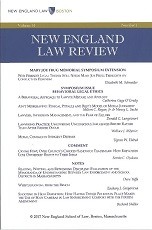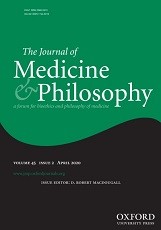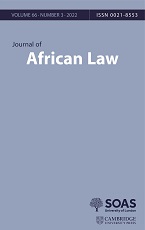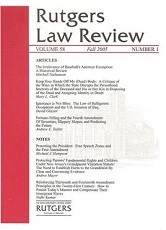Frederick L Brown, Stephen M Kohn, Michael D Kohn

Brown FL, Kohn SM, Kohn MD. Conscientious objection: a constitutional right. New England Law Review. 1985;21: 545-569
Protection of Conscience Project Library
Service, not Servitude

Brown FL, Kohn SM, Kohn MD. Conscientious objection: a constitutional right. New England Law Review. 1985;21: 545-569

Abstract
This essay explores some of the conceptual and moral issues raised by illegal actions in health care. The author first identifies several types of illegal action, concentrating on civil disobedience, conscientious objection or refusal, and evasive noncompliance. Then he sketches a framework for the moral justification of these types of illegal action. Finally, he applies the conceptual and normative frameworks to several major cases of illegal action in health care, such as “mercy killing” and some decisions not to treat incompetent patients.
Childress JF. Civil disobedience, conscientious objection, and evasive noncompliance: a framework for the analysis and assessment of illegal actions in health care. J Med Philos. 1985 Feb 01;10(1):63-83.

Extract
The main purpose of this paper is to summarize the legal status of conscientious objectors in the United States. To accomplish it we would briefly state a background of the law of conscientious objection in the United States and then analyze the current factual situation. . . . The registration has been reinstated by the President of the United States recently and, although no draft has been called, it remains a very real possibility, especially since the volunteer army has not proven satisfactory.51 Should Congress abolish the exemption to bear arms, the important question the Court’s would face is whether or not conscientious objection to war, to a particular conflict or to all, is a right recognized and protected by the Constitution of the United States.
Silva-Ruiz PF. Conscientious objection. Am J Comp Law. 1982 Dec 1;30 Supp 1982:427-437.

Extract
The statement on abortion sponsored by the Canadian Physicians for Life and Les Medecins du Quebec pour le Respect de la Vie (Can Med Assoc J 1981; 125: 922) is an insult to all physicians who support the position of the Canadian Medical Association (CMA) on abortion, including physicians who are members of the Canadian Abortions Rights Action League (CARAL). We categorically reject the charge that we “promote the destruction of the unborn”. The use of the epithet proabortion in reference to either the CMA or the prochoice position is one of many examples of deliberate misrepresentation of the facts surrounding abortion. “Proabortion” applies to those who promote abortion, who favour it as a population control measure; such people live chiefly in India and China. Antichoicers do not recognize this crucial distinction between proabortion and prochoice . . .Are antichoicers now prepared to guarantee that the emotional and physical needs of all unwanted children will be met; to ensure that each one is able to make a life out of the existence that antichoicers would force on it? Hardly. They are interested only in “protecting” the fetus until it is too late for an abortion. They feel no responsibility for the aftermath of compulsory pregnancy for either the mother or the offspring. Their interest is in quantity, not quality of life. . . .These prolife physicians endorse the “moral rights of hospital boards” to protect the “unborn” by depriving women of their legal right to terminate an unwanted pregnancy. History teaches us that whenever the rights of institutions are allowed to ride roughshod over the rights of individuals, humanity as a whole suffers. No publicly funded hospital in this country has any moral right to deprive the women it serves of their legal right to an induced abortion. . . .As long as our laws make it possible for antichoice groups to impose their notions of reproductive morality on other Canadians in this arbitrary fashion, we should all blush in referring to Canada as a democracy.
Watters WW, Cohen M. (Correspondence) Abortion. Can Med Assoc J. 1982 Mar 01;126(5):465. Available from:

Extract
Sex is a pleasurable human activity that should be encouraged, not made taboo by old-fashioned minds that seek to give young people guilty consciences they don’t need. If an unwanted fetus is conceived, there is no point in having an unwanted child in the world, so there should be no obstacle such as an abortion committee to delay the operation.
Wilson DR. (Correspondence) Abortion. Can Med Assoc J. 1982 Jan 01;126(1):21.

Journal Extract
The problem of abortion is not primarily a problem of law. The law clearly addresses the social practice of abortion, it influences the means of practice and may, at its best, resolve the social consequences of abortion, but the problem of abortion is located in social experience and prevailing social philosophies, rather than in statute books and judicial decisions. Abortion lies at the heart of a number of concerns of particular sensitivity, but it can also have a severe medical and personal impact.
Cook RJ, Dickens BM. Abortion laws in African Commonwealth countries. J Afr Law. 1981 Autumn;25(2):60-79.

Biskin JC. The Hyde Amendment: an infringement upon the free exercise clause? Rutgers Law Rev. 1981;33(4):1054-1075.

Extract
The recent incident in Nova Scotia concerning Mr. Hulme, who tried to prevent his estranged wife from having an abortion (see part 2 of this series), resulted in only secondary and indeterminate litigation. . . Mr. Hulme had taken legal action against the Victoria General Hospital in Halifax, whose therapeutic abortion committee had approved the abortion. . . . A therapeutic abortion committee’s alleged liability to judicial reversal suggests it is making a judicial or quasi-judicial decision; however, this is doubtful. . . . Indeed, the only third parties whose interests the committees may have to consider are guardians of the mentally incompetent and parents of minors. . . . hospitals that permit pressure from a third party to interfere with treatment of their competent, consenting adult patients for whom there is a danger to life or health may incur legal and ethical liabilities to such patients. . . Physicians may also face disciplinary charges of professional misconduct. . . .The best solution may be to remove the legal requirement of committee approval and to trust the judgement and good faith of physicians. . .
Dickens BM. Abortion: 3. Therapeutic abortion committees and third parties. Can Med Assoc J. 1981;124(4):362-363. 384.

Extract
It has long been accepted that, legally, “personhood” begins with live birth and that a fetus therefore has no legal status. . . . generally, the rights of the fetus are not recognized, even though the property interests of an unborn child may appear to be protected. . . .This legal procedure simply postpones the distribution of property until the gestation period is over. Similarly, if a fetus is injured in utero and is subsequently found, when born alive, to be affected by the injury, legal action can be taken. However, this is the right of a human being, not of a fetus. . . . On the other hand, if a child is unborn or its life ends in utero, no legal action can be taken on its behalf. [quoting Dehler v. Ottawa Civic Hospital]. . . . [Discusses unresolved 1979 case in Nova Scotia in which an estranged husband and an anti-abortionist prevented an abortion using an injunction and guardianship application] . . . .It seems that Canadian society must rely on such judicial decisions to develop the law on fetal status, protection and legal representation. Politicians and legislatures are wary of the abortion-related furore these topics trigger.
Dickens BM. Abortion: 2. Fetal status and legal representation. Can Med Assoc J. 1981;124(3):253-254.

Summary
Discusses the difference between definitions in the Criminal Code and regulations promulgated by provincial authorities. Notes that post-coital interception (IUD or pharmaceuticals) may be considered abortions. “The problem may become more acute when ‘morning-after’ contraception and menstrual self-regulation with pills and suppositories become widely available. Recent legislation in New Zealand has established that pregnancy begins not with fertilization but with implantation.6 To keep legitimate contraception from coming under the abortion law in Canada we should make a similar provision. However, the recommendation made in August 1980 by the general council of the United Church of Canada – to decriminalize abortion within the first 20 weeks of pregnancy – may be the best solution.”
Dickens BM. Abortion: 1. Definitions and implications. Can Med Assoc J. 1981;124(2):113-114.
[CMAJ] An error appeared in the editorial by Dr. Bernard M. Dickens in the Jan. 15, 1980 issue of the Journal. The second sentence in the second column should read (with the correction in italics): “Furthermore, if the life of the unborn child is deliberately ended after labour begins but before it has an existence outside the mother’s body, the act is considered child destruction, which is lawlul when it is done to save the mother’s life (section 221 [2]).” We apologize to Dr. Dickens for this oversight.
Dickens BM. Abortion:1. Definitions and implications [correction]. Can Med Assoc J. 1981;124(7):854.